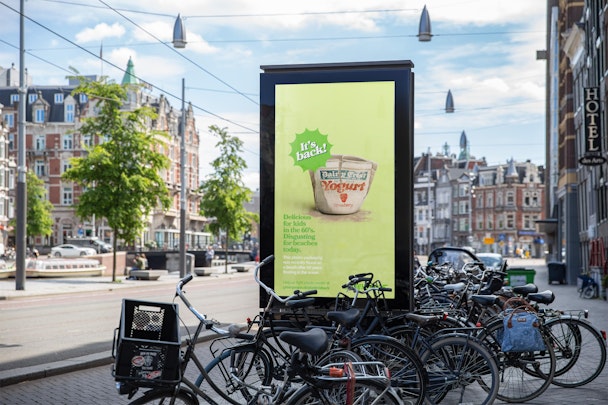OOH is growing, but is it a good thing for the planet?
As part of The Drum's Deep Dive into all things out-of-home, industry leaders and activists weigh in on the sustainable capabilities of the medium.

Greenpeace recently used an OOH campaign to promote recycling/ Image via Greenpeace
OOH, especially digital, is booming. Market research has found that the number of digital OOH (DOOH) screens increased by 43% between 2017-2020 in the US. In the UK, Clear Channel estimates there are 30,000 DOOH panels in the UK. This number covers everything from billboards and bus stops to small window displays.
With so many screens, understanding the environmental impact of digital billboards has become a concern for some in the industry. But measuring it has been a challenge. Christopher Sewell, chief executive and founder of Net Zero Media says there isn’t one metric – officially. “16 years ago I developed a methodology which I took to Carbon Trust in the UK. At the time, there was no official standard… and I’ve been working on it ever since. But not a lot has really happened until the last two years, when we all started to talk about net zero targets.”
Since then, various media agencies and owners have developed their own tools for measuring the carbon output of OOH and DOOH across the buying chain. The IPA’s carbon calculator has been widely adopted while IPG and MediaCom have recently inked a net zero media buying partnership with Scope3 to understand the full carbon impact of OOH, among other platforms.
But according to Sewell, this should have been done 10 years ago. “The advertising industry has jumped on board very late in the game.”
According to Tim Lumb, insight and effectiveness director at Outsmart, the challenging measure is the one that weighs up the price of emissions versus impact. And on that, OOH is one of the most efficient mediums marketers can choose. “Carbon calculators show that on a carbon-per-impression delivered basis (for example, tCO2e/Mill) OOH is very efficient. For brands seeking to reduce the carbon emissions of their advertising, OOH is the clear choice,” explains Lumb.
But there are still improvements that can be made. He cites a number of ways in which media owners can take control of the supply chain and reduce their emissions further, such as powering screens down at night or powering them with energy purchased from renewables. He also adds that innovating through technology by installing or upgrading screens with significantly reduced energy consumption, such as adaptive brightness, LED lighting and recycled paper is the future for OOH.
“Media owners can also be investing in sustainable infrastructures, like vertical meadows, solar panels, air cleaning units, recycled construction materials, electric vehicle fleets, air quality sensors, temperature sensors, traffic monitoring.”
He finally notes the capacity of OOH to promote sustainable lifestyles and trends. Indeed, one of this year’s most memorable 3D billboards came from the Woolmark Company, in its ad that challenged the use of synthetic materials used in clothing.
So could OOH work in the public’s interest? Lumb says yes, through ad-funded sustainability projects and community initiatives such as playgrounds, tree planting, sustainability partnerships and community clean-up projects, working with wildlife trusts.
“OOH advertising funds the installation, renewal, cleaning, and maintenance of public infrastructure, particularly in public transport and communications," he says. "In 2018, PwC estimated that approximately 40% of OOH advertising revenue goes back into the UK economy. Good public transport reduces overall vehicle journeys, which are a key source of emissions."
Both Sewell and Lumb also point out that the long-tail on OOH and DOOH impact are preferable to say, email, or click through as they are placed in communal areas and public spaces, such as transport.
“Public transport is a great medium because it can be printed on paper, and hopefully that’s recycled,” says Sewell. “There’s really no footprint because the trains run regardless and as long as it’s not digital, it makes no difference to the amount of electricity the train uses to run.”
However, there is a growing activist movement against the presence of advertising within public spaces. AdFree Cities is an organization that lobbies against the installation of new digital billboards being installed across the UK.
“Digital screens are preferred by advertisers because of the increased profits from a rolling display of several ads per minute. But as the UK faces energy shortages and a linked cost of living crisis the large power requirement for these brightly lit screens is raising uncomfortable questions,” says counter-greenwash campaigner at AdFree Cities, James Ward.
Meanwhile, art director Robbie Gillett reminds us that we are currently in an energy crisis, “And digital advertising screens are consuming huge amounts of power for little social value and active environmental harm such as ads for junk food, fast fashion and high carbon products. No wonder these screens were one of the first things to be switched off when countries in Europe needed to save energy to avoid shortages this year.
“We are petitioning the UK government to follow the example of Germany, Austria, France and Spain and mandate that digital ad screens are switched off at night to save energy.”
But overall, AdFree Cities wishes that we could few adverts across the board, as the consumption it drives contributes to an uptick in emissions, or ‘Advertised Emissions’ – 32% per year to the average carbon footprint of a UK consumer, according to a study by Purpose Disruptors.
In a recent interview with The Drum, Seb Munden, chair of the Advertising Association’s sustainability bid, Ad Net Zero told us that the industry ought to act faster on minimizing its carbon output across its supply chain – particularly media and OOH. “We’re going to have to have pre-competitive collaboration to establish the carbon footprint of various channels.”
He also expressed that although “we can never do enough” to shift desires and behaviors towards more sustainable lifestyles, “I don’t think advertising can do everything, and I’m not sure it should be held accountable for a footprint beyond its own,” branding sales attribution as a “dark art.”
According to the Greenhouse Gas Protocol, which breaks down the different types of emissions businesses can create into Scopes 1, 2 and 3, the third area in which industries must address its impact on the planet includes indirect emissions, or those that occur in the value chain of a company.
Gillett says therefore, that while minimising the environmental impact of OOH and DOOH is worthwhile, the quickest thing the advertising industry can do to immediately lower its carbon footprint is to stop advertising the most damaging product categories. "Namely cars, airlines and fossil fuel companies," he says.

